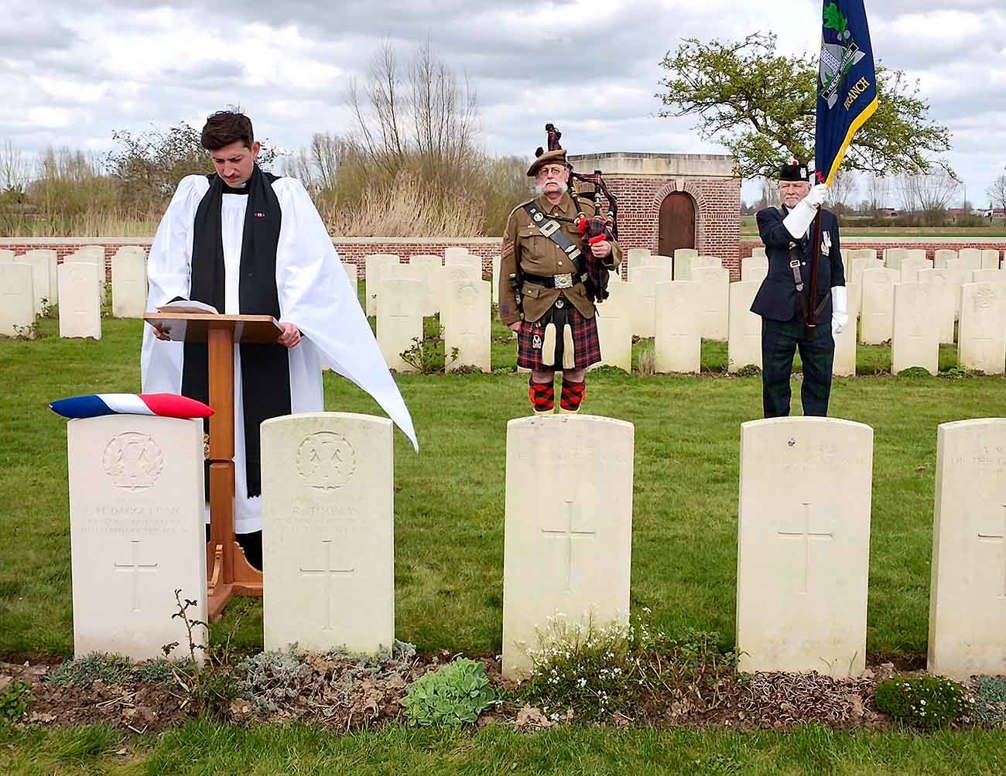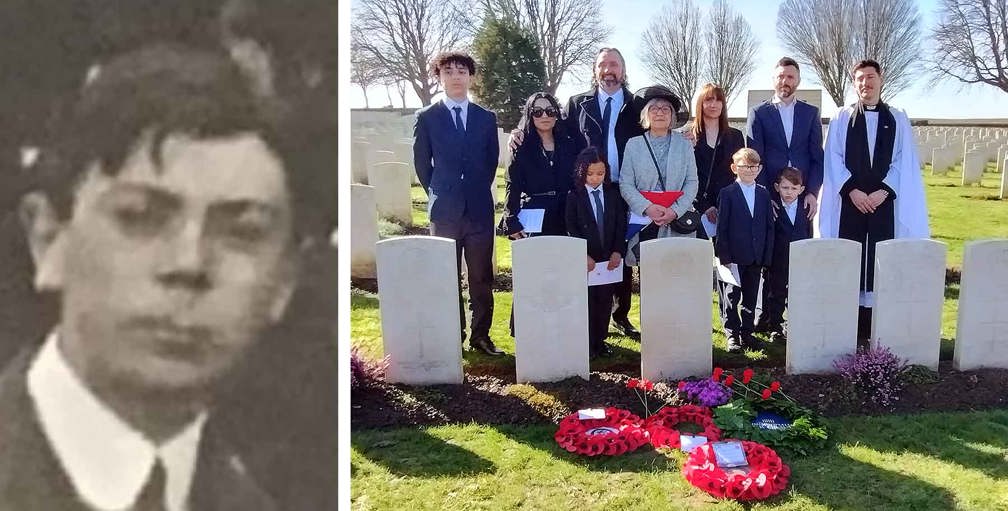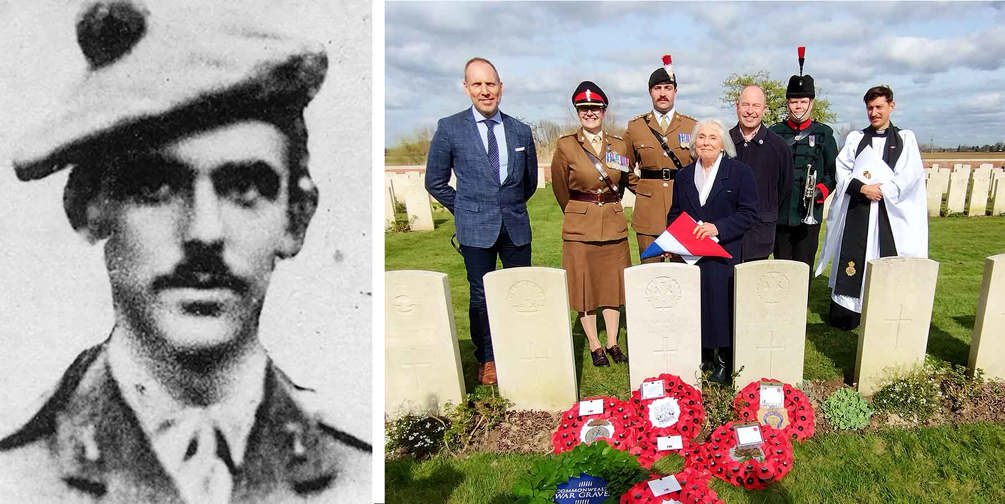19 March 2024
Rededication services held in France for Private Harold Stanley Harvey and Captain Cedric Hunton Daggett MC

Reverend Thomas Sander with members of the Tyneside Scottish Association (Crown copyright).
The graves of two World War One soldiers, one whose gun jammed while being attacked in freezing conditions and another who died trying to save his wounded men, have now been marked by name more than a century after their deaths.
The rededication services for Private (Pte) Harold Stanley Harvey of The Middlesex Regiment (Duke of Cambridge’s Own), and Captain Cedric Hunton Daggett MC of The Northumberland Fusiliers were organised by the MOD’s Joint Casualty and Compassionate Centre and were held at the Commonwealth War Graves Commission’s Cabaret Rouge British Cemetery and Rue-Petillon Military Cemetery on 19 March 2024.
Private Harold Stanley Harvey

Private (Pte) Harold Stanley Harvey (copyright unknown). Pte Harvey’s family stands behind his headstone (Crown copyright).
Harold Stanley Harvey was the son of W.D. Harvey, of 117, Nightingale Lane, Hornsey, London. By early 1917, Private Harvey (TF/200792) was serving as a Lewis-gunner in the 1st/7th battalion Middlesex Regiment.
On 13 January 1917, Private Harvey was holding an outpost near Fauquissart, when it was raided by a German party. The Lewis-gun jammed, and the German trench-raiding party overwhelmed the position, wounding the 20-year-old Private Harvey. Private Harvey was subsequently taken to Fournes as a prisoner of war, where he succumbed to his wounds. He was buried by the Germans in the nearby German cemetery.
After the war, when the cemeteries from the immediate area were concentrated into Cabaret-Rouge British Cemetery, it was not possible to link the unknown grave to Harvey at the time and he was commemorated on the Loos Memorial. Contemporary research has, however, made it possible to identify the grave over 100 years after Harvey’s death. The Commonwealth War Graves Commission will now care for Private Harold Harvey’s grave in perpetuity.
A member of the public submitted a case hoping to have identified the grave of an unknown soldier of the Middlesex Regiment with a likely date of death of 14 January 1917 buried in Cabaret-Rouge British Cemetery. The original enquirer believed the unidentified grave XV.G.26. was in fact that of Private Harold Stanley Harvey, of the 1st/7th Middlesex Regiment.
Through extensive research conducted by the CWGC, the National Army Museum, and JCCC, it was possible – based on a meticulous process of elimination – to ascertain that there was clear and convincing evidence linking Private Harvey to the grave.
JCCC Caseworker, Alexia Clark, said:
“Being involved in finding out what happened to Pte Harvey all those years ago has been such a privilege. I am grateful to the researcher who brought the case to our attention, and proud to have been able to finally give Pte Harvey’s family some answers.”
Members of Pte Harvey’s extended family were in attendance at the service, the epitaph provided by the relatives reads: ‘He gave his life so that we could live ours.’
Captain Cedric Hunton Daggett

Capt Cedric Hunton Daggett MC (courtesy IWM). Relative of Captain Daggett stands behind his headstone (Crown copyright).
Cedric Hunton Daggett was the son of the late William Daggett and Eva Daggett, of 14, Saville Chambers, Newcastle-on-Tyne. Daggett joined the 23rd (Tyneside Scottish) Bn. Northumberland Fusiliers in France a few months before the Somme offensive.
The then Second Lieutenant Daggett participated in the opening day of the battle of the Somme, in which the battalion suffered terrible losses. With many of the officers killed or wounded after the opening day, Daggett was made company commander of A Company. Just two months later, in September 1916, Daggett was promoted to Captain.
On 11 February 1917, the 23rd (Tyneside Scottish) Bn. Northumberland Fusiliers were tasked to raid a German trench in the Rue du Bois sector. Daggett, who had been awarded the Military Cross in the January 1917 New Year’s Honours list, was in command of A company on the left flank of the battalion. The attack met fierce resistance, and Captain Daggett was last seen standing on the parapet of a German trench having said he was going to assist his men who were under heavy fire. The battalion was forced to retire, and Captain Daggett was listed as missing.
Daggett was wounded and taken prisoner by the Germans. Unfortunately, the 27-year-old was to succumb to his wounds. He was buried by the Germans at Lambersart on 12 February 1917. His remains were concentrated into Rue-Petillon after war. Captain Daggett was previously commemorated on the Ploegsteert Memorial to the missing. His name will be removed once the appropriate panel is restored and his new headstone in Rue-Petillon Military Cemetery will be cared for by the CWGC in perpetuity.
A member of the public submitted a case hoping to have identified the grave of an unidentified officer with a likely date of death of 11 February 1917 buried at Rue-Petillon Military Cemetery. The original enquirer believed that grave II.A.25 was in fact that of Captain Cedric Hunton Daggett, of the 23rd (Tyneside Scottish) Bn. Northumberland Fusiliers. The unknown officer had been concentrated to Rue-Petillon Military Cemetery from the Lambersart Communal Cemetery German Extension.
Again through extensive research conducted by the CWGC, the National Army Museum, and JCCC, it was possible to ascertain clear and convincing evidence linking Captain Daggett to the grave. Daggett was the only officer to still be missing from the timeframe of the date of date to also match the recovery and initial burial location.
JCCC Caseworker, Rosie Barron, said:
“It has been a privilege to have organised this rededication service today and to have played a part in the identification of Capt Daggett’s grave. He was clearly a very popular, capable and brave young Officer, who lost his life whilst assisting his wounded men. It is important that the memory of men such as Capt Daggett is kept alive, and his sacrifice is not forgotten.”
The services were conducted by the Reverend Thomas Sander CF, Chaplain to The Household Cavalry and were attended by representatives from The Princess of Wales’s Royal Regiment and The Royal Regiment of Fusiliers.
The Reverend Sander said:
“There is something of profound importance rededicating the graves of fallen soldiers. Even though many years have passed we once again commit Private Harvey and Captain Daggett to God's care and keeping and to our sacred memory. In doing so we give thanks for the courage of all those who died in the cause of war and we continue to pray for peace in our world.”
Mel Donnelly, CWGC Head of Commemorations said:
“To learn about the final days of these brave men is truly heart-breaking, but such was the fate of many of their comrades. We give our thanks to all those who have helped in identifying their final resting places. It is our privilege to help honour their memory and to care for their graves in perpetuity.”

